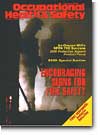
August 2005
Features
By Josephine Elizabeth Kenney, J.D.
ABOUT a year ago, on April 13, 2004, the U.S. Department of Health and Human Services' Substance Abuse & Mental Health Services Administration (SAMHSA) published a Notice of Proposed Rulemaking proposing revisions to the Mandatory Guidelines for Federal Workplace Drug Testing Programs.
By Jerry Laws
Editor's note: How can a safety manager persuade both corporate management and workers to comply with NFPA 70E, the consensus standard addressing electrical safety requirements for workplaces? Read on to see how Gary McGuire solved the problem. McGuire is safety coordinator at the Newberg, Ore., mill of SP Newsprint Co. (www.spnewsprint.com), which is based in Atlanta, Ga., and produces more than 1 million tons of newsprint annually.
By Jerry Laws
Editor's note: A trend to require more fire safety equipment in residences and nursing homes will reduce deaths and injuries, both among firefighters and the general public, says E. Metts Hardy, vice president/Fire Investigations for EFI Global (www.efiglobal.com), a Kingwood, Texas-based provider of engineering, fire investigation, environmental, accident reconstruction, and laboratory testing services.
By Fred Elliott
WHAT are the biggest safety problems on summer construction sites? Noise, moving vehicles, heat, and falls from height come readily to mind. But some of the most common hazards are more subtle: Communication problems, poor housekeeping, and a wrongheaded safety approach are factors.
By Jerry Laws
Editor's note: Rapid innovation in user-friendly radiation detection devices is helping emergency responders and civilian users alike, says Thea Philliou, a first responder applications specialist for Thermo Electron's Security group. Products are increasingly smarter, stronger, and smaller in response to users' needs, she explained in a March 1, 2005, conversation with Occupational Health & Safety's editor. Excerpts from the conversation follow.
By Matt Thiel
A worker is about to enter a confined space. Prior to entry, he reaches down to his belt and pulls out his gas monitoring device. He points the device into the confined space and initiates a scan of the entire area. Beams of light emit out of the instrument in all directions and cover the entire interior of the confined space.
By W. Jon Wallace, CSP, MBA
Approximately 80 percent of all electrical injuries are burns that result from the electric arc flash and ignition of an employee's flammable clothing. Arc flashes cause electrical equipment to explode, resulting in an arc-plasma fireball.
Departments
By Matthew A. Forck
Isiah Thomas left Indiana University after two years and at age 19 was the fourth pick in the 1982 NBA draft. Much to his dismay, the lowly Detroit Pistons selected him. Detroit was a team without a tradition or identity; in fact, its players had won just 16 of 82 games in the previous season.
By Jerry Laws
I don't expect you to read and remember every word published in this magazine, Dear Reader. But I hope the contents benefit you always and educate you sometimes.
By Emily Bryant
GERMS are the last things you want to find occupying your workspace, especially in a health care facility, but it's nearly impossible to eliminate them all, given the propensity for sanitary rule-breaking that occurs among any human population.